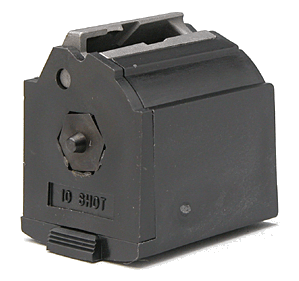| Ruger 10/22® Magazine Maintenance |
 |
|
At Gunsmoke Engineering I get a lot of email from folks that are having problems with reliable cartridge feeding, usually from aftermarket magazines.
Ruger factory magazines are very good in this regard, but hard use or manufacturing defects can cause problems for these magazines as well.
In the following paragraphs I'll describe some of the more common magazine related problems and show some tips for dealing with them. I'll also show how to disassemble and clean the Ruger magazine to restore it to as-new condition.
The most trouble I've had with feeding came from faulty, poorly designed, aftermarket mags. In my experience, RamLine mags are among the worst in this regard: I once had six mags of this type that wouldn't reliably feed. I went to the RamLine factory in Golden, Colorado and exchanged them for six new mags, and none of those would feed either. All six ended up in the trash. I've had good luck with Eaton Supply Inc. 25 round magazines, and also with Butler Creek "Hot Lips" magazines. If you must use an aftermarket magazine, the best you can do is the Butler Creek "Steel Lips" mag. All of the mags mentioned so far, except the Ruger and "Steel Lips", use plastic for their construction, and the feed lips that guide the cartridge into the chamber are prone to wear and will eventually start to give feed problems. This doesn't happen with the Ruger and "Steel Lips" mags, since the feed lips are made from steel which is much harder than the brass cartridges which pass through them. Feed problems can also be caused by dirty magazines. Unfortunately, all of the aftermarket magazines I'm familiar with are permanently assembled and can not be taken apart for cleaning. About the best you can do for these is to brush off the feed lips and follower with a toothbrush and some evaporating solvent, like Birchwood Casey "Crud Cutter" or electrical contact cleaner. Best do this outside where the vapors won't give you breathing problems. Leave the magazines upside down to drain and dry after doing this, and don't put any oil into them because the oil will trap dirt in the mags. The Ruger mags are the best, and if that's what you're using and you still have feed problems, it could be that it wasn't assembled at the factory properly. It could also be that the mag interior is dirty. The Ruger magazine is easily serviced. Here's how:
Reprinted from Gunsmoke Engineering. |
| Unless otherwise specified, all material herein is Copyright © 2010 J Carr Associates.
All rights reserved.
No part of these pages may be copied or reproduced, in any form, without the expressed written permission of J Carr Associates. If we have inadvertently used any artwork that is NOT in the public domain without permission, we apologize. Let us know and we'll remove it. |